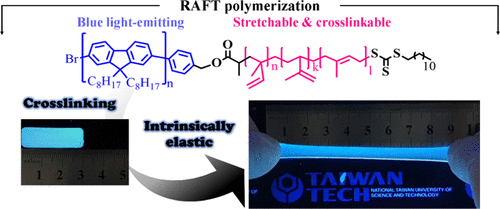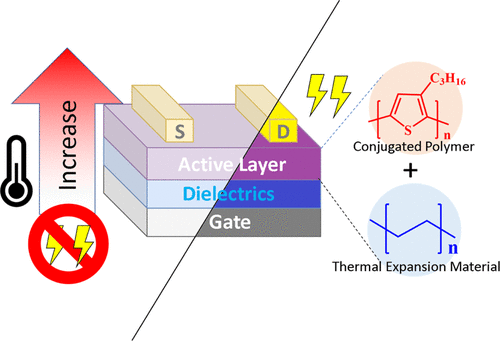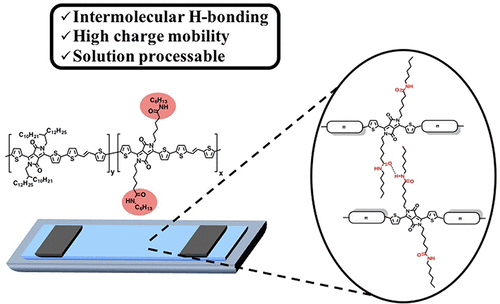


Polymer Morphology & Electronics Lab.
July 29, 2020
賀!邱昱誠助理教授榮獲
2020年中華民國界面科學學會 “傑出青年學者獎”
July 29, 2020
賀!研究生 Livy Laysandra 榮獲
2020年中華民國界面科學學會年會暨科技部計畫成果發表會 “口頭報告入圍”
June 30, 2020
賀!專題生 黃彥馨同學榮獲 “109年度 大專學生研究創作獎”
January 01, 2020
NEWS!研究生 張家睿同學 將於北海道大學 進行研究合作 (2020.01~2020.03)
July 01, 2020
NEWS!研究生 若海依同學 將於東京工業大學 進行研究合作 (2019.07~2019.09)
January 18, 2019
賀! 研究生 莊敬恆同學榮獲
2019中華民國高分子學會年會、第42屆高分子學術研討會暨科技部107年度高分子學門成果發表會以及前瞻高分子科學與技術國際研討會 “壁報競賽佳作”
August 01, 2019
賀! 2018.08 李彥庭 同學 榮獲 “2018年度李長榮博士生獎學金計畫”
July 22, 2018
Title : Intrinsically Stretchable and Healable Semiconducting Polymer for Skin-Inspired
Wearable Transistors
June 14, 2018
NEWS! 邱昱誠 助理教授 獲選為 北海道大學 工學部 特任助理教授 (2018.06-2018.09)
June 07, 2018
Prof. Yu-Cheng Chiu invited to give a talk at 2018 1st Asian-France Workshop (1st AFW) on "Soft Matter Self-Assembly & Applications", Grenoble, France.
Title : From functional polymers to intrinsically stretchable and healable organic transistors
April 30, 2018
NEWS! 研究生 莊靖恆 同學 獲得北海道大學 Internship Program, 將於北海道大學進行合作研究 (2018.07-2018.09)
Feb 28, 2018
Polymer Semiconductor!
Our research published in Macrocolecules (IF:5.914) !
Title: Amide- Containing Alkyl Chains in Conjugated Polymers: Effect on Self-Assembly and Electronic Properties. (Macromolecules, 2018, 51, 1336.)
February 01, 2018
賀! 2018.02 邱昱誠 助理�教授 榮獲 臺灣科技大學年輕學者研究獎 (106年度)

December 02, 2017
One of Yu-Cheng's Work reported on SIGMA-ALDRICH : Polymer Semiconductors for Intrinsically Stretchable Organic Transistors
Aug 01, 2017
"Light Recorder" ! Our research published in Advanced Materials (IF:21.950) !
Title: Non-Volatile Perovskite-based Photomemory with a Multi-Level Memory Behavior. (Adv. Mater. 2017, 29, 1702217.)
September 04, 2017
Prof. Yu-Cheng Chiu gave an invited talk at 2017 Japan-Taiwan Bilateral Polymer Symposium (2017 JTBPS), which was held at Yonezawa, Japan.
Title : Intrinsically Stretchable and Healable Semiconducting Polymer for Skin-Inspired Wearable Transistors
Jan 09, 2017
Semiconductors that stretch and heal! Our research reported by Nature NEWS !
Nature News (Nature, 2016, 539, p365-367) 報導 研究成果 "可拉伸與修復的半導體"
Yu-Cheng's Work Featured on Nature News, Physics Today, C&EN, Phys.org, AZo Materials, nanotechweb.org, and medicalphysicsweb.org
January 09, 2017
研究成果獲得 Nature News, Physics Today, C&EN, Phys.org, AZo Materials, nanotechweb.org, and medicalphysicsweb.org 報導
LINK: 1. Nature News 2. Physics Today 3. C&EN 4. Phys.org 5. AZo Materials 6. nanotechweb.org 7. medicalphysicsweb.org
November 20, 2016
http://www.nature.com/nature/journal/v539/n7629/full/nature20102.html
Great News!
Yu-Cheng's (Co-first author) wrok with Dr. Simon Rondeau-Gagné, Dr. Jin Young Oh, and Prof. Zhenan Bao on "Intrinsically stretchable and healable semiconducting polymer for organic transistors" has been published on NATURE ! Congrats to all co-authors!
August 11, 2016
Prof. Yu-Cheng Chiu gave an invited talk at 2016 International Symposium for Advanced Materials Research (ISAMR 2016), which was held at Sun Moon Lake, Taiwan!
Title : TBA
OUR LATEST RESEARCH

A huge challenge for developing self-healing materials is achieving a good compromisation between mechanical properties and self-healing efficiency. For this purpose, a facile route by introducing N-(hydroxymethyl)acrylamide (NMA) as a thermal-catalyzed self-cross-linker as well as a self-healing material into a soft polymer system for tuning the mechanical properties in an easy way, resulting in elastic and self-healing properties through a covalent and dynamic network simultaneously, represents an exciting avenue for the development of self-healing materials.This work provides insight into the future design of materials with elastic, self-crosslinking, and self-healing properties, which are adjustable depending on the desired applications.

An easy and novel synthetic concept for building intrinsically stretchable and elastic semiconducting polymers is designed in this study, in which a conjugated rod–coil block copolymer with a rigid poly(9,9-di-n-octyl-2,7-fluorene) (PFO)-conjugated rod and soft poly(isoprene) (PI) coils were utilized as model compounds for demonstration. The PF-b-PI1.8 thin film could not only be stretched by up to 150% without forming any cracks but also be employed for the fabrication of free-standing films with both excellent elasticity and tough mechanical strength after cross-linking, showing high stability in quantum yield over 1000 stretching cycles at 150% strain.

A rational side-chain engineering was performed on a semicrystalline semiconducting conjugated polymer based on diketopyrrolopyrrole (DPP) to incorporate metal-chelating moieties without disruption of the π-conjugation. The resulting semiconducting metallopolymer was shown to possess a good solubility in common organic solvents after complexation and a smooth morphology at the nanoscale. The electronic properties of the new metallopolymer were evaluated through fabrication of organic field-effect transistors (OFETs).
(J. Mater. Chem. C, 2020, 8, 8213-8223.)

Tacky Elastomers to Enable Tear-Resistant and Autonomous Self-Healing Semiconductor Composites
Mechanical failure of π‐conjugated polymer thin films is unavoidable under cyclic loading conditions, due to intrinsic defects and poor resistance to crack propagation. Here, the first tear‐resistant and room‐temperature self‐healable semiconducting composite is presented, consisting of conjugated polymers and butyl rubber elastomers. Autonomous self‐healing at room temperature, both mechanical and electronic, is demonstrated through the physical contact of two separate films. The composite film also shows device stability in the ambient environment over 5 months due to much‐improved barrier property to both oxygen and water.

Novel stretchable light‐emitting diodes based on conjugated‐rod block elastic‐coil copolymers
An intrinsically stretchable light‐emitting diode (LED) by using a new conjugated rod–coil block copolymer, poly[2,7‐(9,9‐dioctylfluorene)]‐block‐poly(isoprene) (PF‐b‐PI). ( PF conjugated rods and PI coils exhibited fluorescent and intrinsically stretchable properties, respectively. These results demonstrated that the luminescent PF12K‐b‐PI5K rod–coil block copolymers exhibit exceptional stretchability and high stability; these copolymers can be used in stretchable LEDs for a wide range of applications.

The molecular structure of polymer electrets is crucial for creating diverse functionalities of organic field-effect transistor (OFET) devices. Herein, a conceptual framework has been applied in this study to design the highly photoresponsive carbazole-based copolymer electret materials for the application of photoresponsive OFET memory. Our copolymers exhibited efficient visible-light absorption and photoluminescence quenching in the film state, indicating the formation of a considerable number of nonemissive excitons, one of the crucial factors for achieving photoinduced recovery behavior in OFET memories.
(ACS Appl. Mater. Interface., 2020, 12, 6144-6150. )

Exploitation of Thermoresponsive Switching Organic Field-Effect Transistors
A novel thermoresponsive switching transistor is developed through the rational design of active materials based on the typical field-effect transistor (FET) device configuration, where the active material is composed of a blend of a thermal expansion polymer and a polymeric semiconductor. It is revealed that owing to the thermistor property of PE, the FET characteristics of the derived device will be largely decreased at high temperatures (100–120 °C). Our results demonstrate a facile and promising approach for the development of next-generation overheating shutdown switches for electrical circuits.
(ACS Omega, 2019, 4, 22082-22088.)

A new design concept for novel photoresponsive flash organic field‐effect transistor (OFET) memory is demonstrated by employing the carbazoledioxazine polymer (Poly CD) as an electret. Photoactive electrets that can absorb the light effectively rather than photoactive semiconductors are proposed by the “photoinduced recovery” mechanism in the literature; however, the correlation between the chemical structure and photoresponsive electrical performances is ambiguous. In this study, it is reported for the first time that the OFET memory with trapped charges can be optically recovered by a polymer electret and the working mechanism can be explained by the structural design.

Morphology and Electronic Properties of Semiconducting Polymer and Branched Polyethylene Blends
A new strategy for influencing the solid-state morphology of conjugated polymers was developed through physical blending with a low-molecular-weight branched polyethylene. By using the new polyethylene-based additive, the concentration of a conjugated polymer required for the fabrication of organic field-effect transistor devices was reduced down to 0.05 wt %, without affecting charge transport, which represents a significant improvement compared to usual concentrations used for solution deposition.
(ACS Appl. Mater. Interface., 2019, 11, 12723-12732.)

A simple and efficient strategy to modulate the self-assembly and solid-state morphology of conjugated polymers has been developed by incorporating various amounts of amide-containing alkyl side chains to high charge carrier mobility conjugated polymers based on diketopyrrolopyrrole (DPP). The incorporation of hydrogen-bonding moieties allowed for an improvement of the charge carrier mobility in organic field-effect transistors (OFET) devices, which achieved a maximum value of 2.46 cm2/(V s) at 5 mol % of amides. Therefore, controlled self-assembly of conjugated polymers through hydrogen-bonding side chains is a promising strategy toward more efficient semiconducting polymers for thin film transistors and other organic electronics.
(Macromolecules, 2018, 51, 1336.)

Partially-Screened Field Effect and Selective Carrier Injection at Organic Semiconductor/Graphene Heterointerface
(collaboration with Prof. Chih-Jen Shih, ETH)
Due to the lack of a bandgap, applications of graphene require special device structures and engineering strategies to enable semiconducting characteristics at room temperature. To this end, graphene-based vertical field-effect transistors (VFETs) are emerging as one of the most promising candidates. Here, we report the first experimental evidence that the partially screened field effect and selective carrier injection through graphene dominate the electronic transport at the organic semiconductor/graphene heterointerface.
(Nano Letters, 2015, 15, 7587–7595)

Oligosaccharide Carbohydrate Dielectrics toward
High-Performance Nonvolatile Transistor Memory
Devices
Oligosaccharides are one of the most promising biomaterials because they are abundant, renewable, diversified, and biosourced. The use of oligoor polysaccharides for high-performance nonvolatile organic field-effect transistor memory is demonstrated herein. The charge storage mechanism is attributed to charged hydroxyl groups that induce stronger hydrogen bonding, thus leading to the stabilization of trapped charges. This study reveals a promising future for green memory devices.
(Adv. Mater., 2015, 27, 6257-6264)

Impact of Polystyrene Oligomer Side Chains on Naphthalenediimide-Bithophene Polymers as N-type Semiconductors for Organic Field-Effect Transistors
Improved air stable n-type semiconducting property is observed in naphthalene diimide–bithiophene polymers by attaching polystyrene (PS) oligomer side chains. The PS side chains are attached to the conjugated backbone via a termination process of living anionic polymerization. The improved air stability is attributed to the covalently attached PS side chains potentially serving as a molecular encapsulation layer.
(Adv. Funct. Mater., 2016, ASAP)

High-Performance Nonvolatile Transistor Memories Using the Green Electrets of Sugar-based Block Copolymers and Their Supramolecules
Sugar-based block copolymers, maltoheptaose-block-polystyrene (MH-b-PS), and their supramolecules are employed as electrets toward a highperformance organic field-effect transistor (OFET) memory, where the morphological transformation of polyhydroxylated MH cylinders surrounded by the PS matrix dominate the electrical switching characteristics of the OFET memory.
(Adv. Funct. Mater., 2014, 24, 4240-4249.)

Conjugated Polymer Nanoparticles as Nano Floating Gate Electrets for Charge-Storage Materials
(collcollaboration with Dr. Chien-Chung Shih, NTU)
A molecular nano-floating gate approach using conjugated polymer nanoparticles is developed for achieving high performance charge-storage materials. Using discrete polyfluorene and poly(fluorene-alt-benzo[2,1,3]thiadiazole nanoparticles the floating gates in a transistor device can effectively capture the field-induced electrons and lead to a distinct memory behavior.
(Adv. Funct. Mater., 2015, 25, 1511-1519.)

.jpg)






